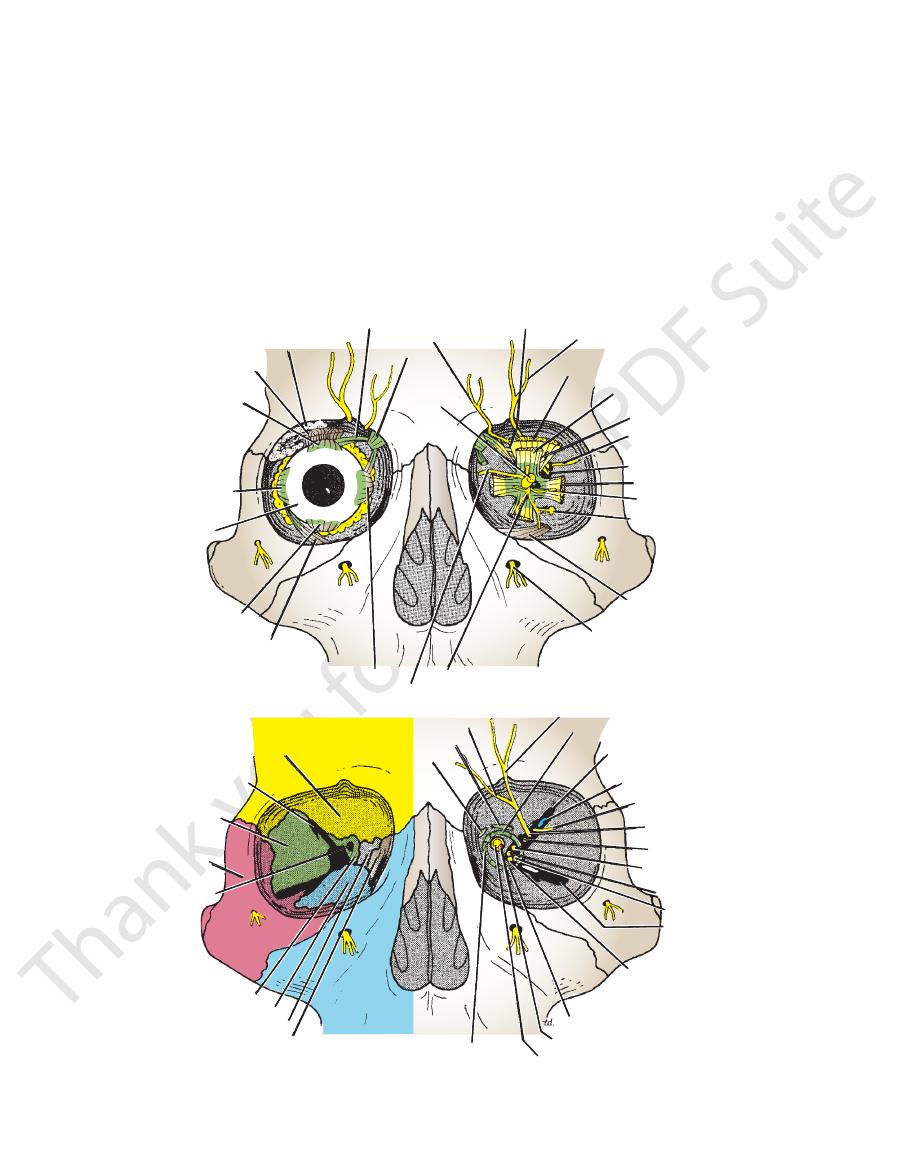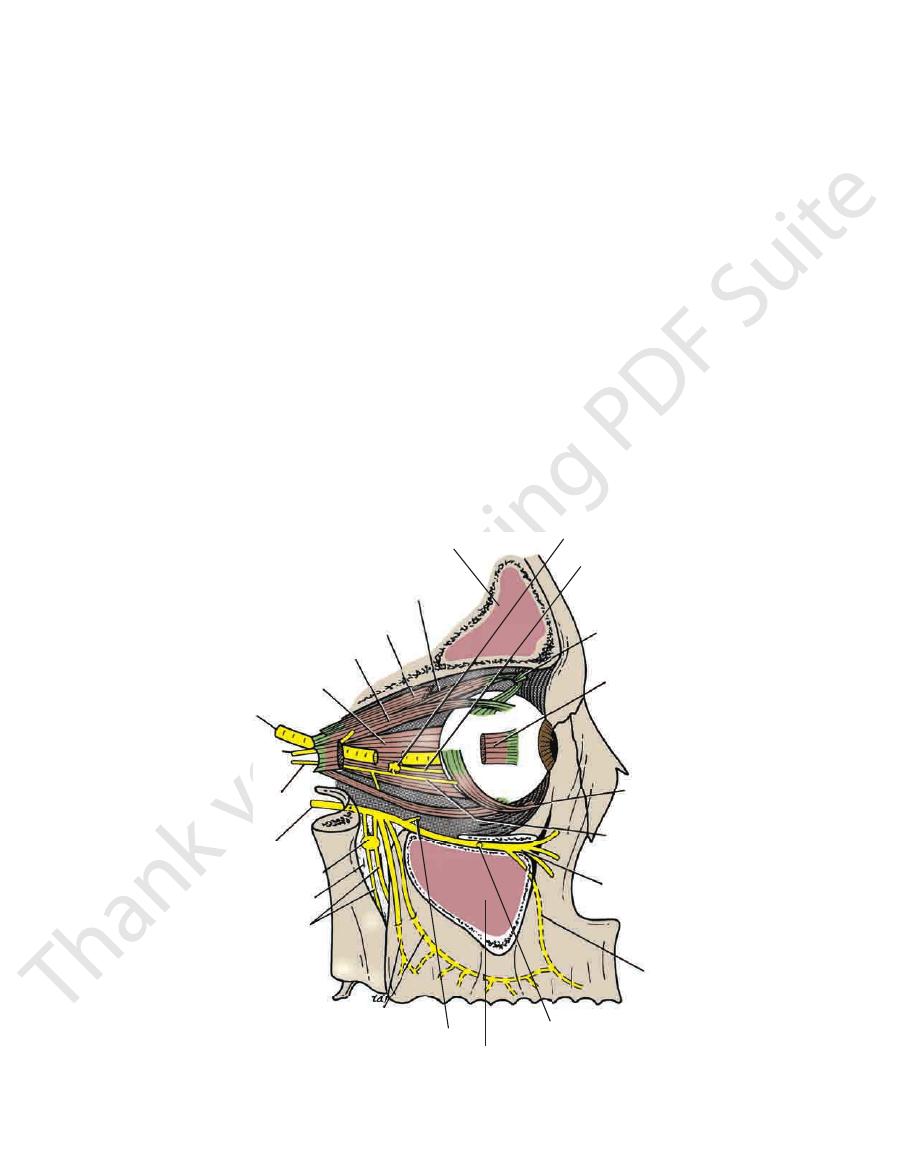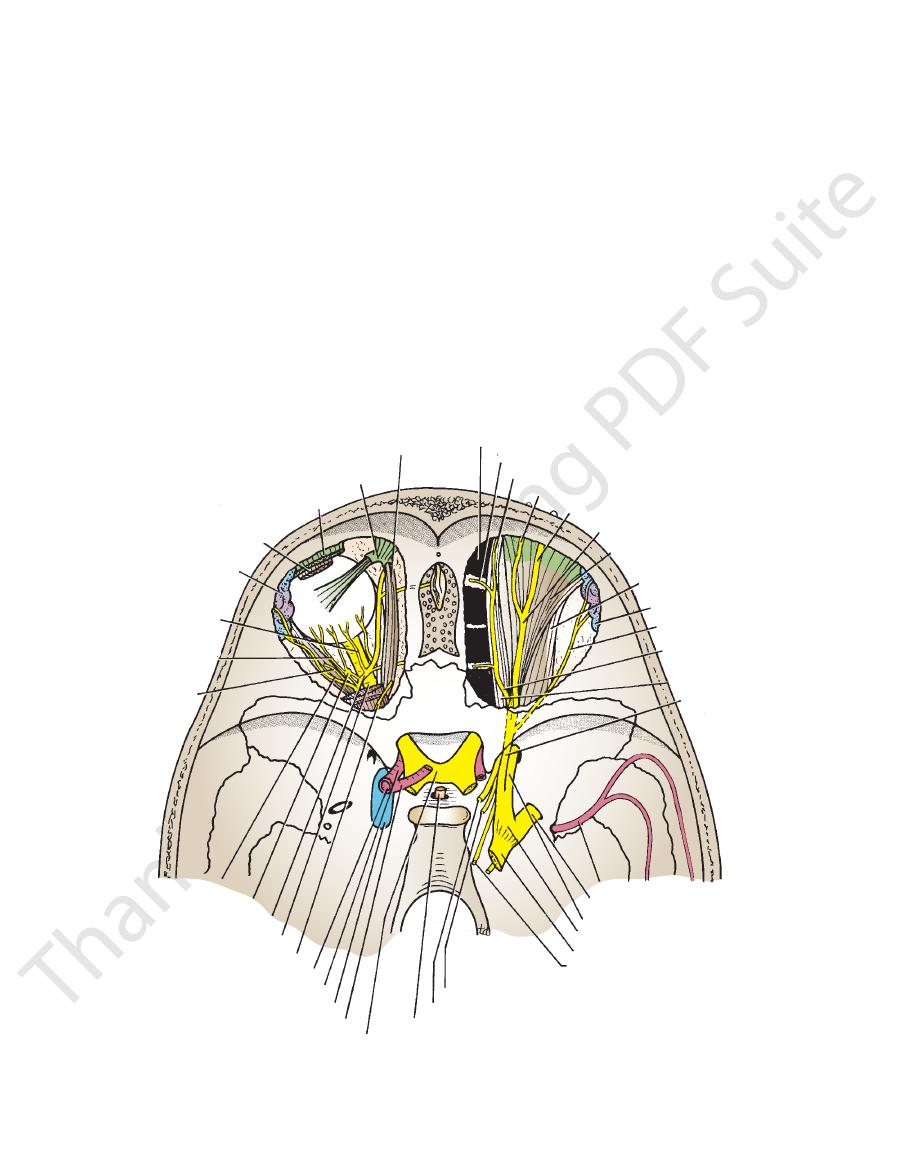
552
CHAPTER 11
the maxilla and the frontal bone.
illa, and the medial margin is formed by the processes of
rior margin is formed by the zygomatic bone and the max
the processes of the frontal and zygomatic bones, the infe
above by the frontal bone, the lateral margin is formed by
is formed
orbital margin
apex posterior (Fig. 11.18). The
The orbit is a pyramidal cavity with its base anterior and its
forced up the duct into the lacrimal sac on blowing the
This prevents air from being
lacrimal fold.
known as the
The opening is guarded by a fold of mucous membrane
bony canal and opens into the inferior meatus of the nose.
The duct descends downward, backward, and laterally in a
emerges from the lower end of the lacrimal sac (Fig. 11.16).
is about 0.5 in. (1.3 cm) long and
nasolacrimal duct
The
nasolacrimal duct.
medial palpebral ligament and is the upper blind end of the
(Fig. 11.16), which lies in the lacrimal groove behind the
The Head and Neck
nose.
The Orbit
Description
-
-
superior oblique
lacrimal gland
levator palpebrae
superioris
superior rectus
lateral rectus
sclera
inferior rectus
inferior oblique
medial rectus
nasociliary nerve
lower division of
oculomotor nerve
infraorbital nerve
inferior oblique
ciliary ganglion
abducent nerve
lateral rectus
trochlear nerve
lacrimal nerve
upper division of
oculomotor nerve
superior rectus
levator palpebrae superioris
supraorbital nerve
trochlear nerve
supratrochlear nerve
optic nerve
trochlea
A
B
C
D
orbital plate of frontal
superior orbital
fissure
greater wing of
sphenoid
zygomatic
optic canal
lesser wing of
sphenoid
maxilla
ethmoid
lacrimal
medial rectus
optic nerve
ophthalmic artery
inferior rectus
lower division of
oculomotor nerve
inferior
orbital
fissure
abducent
nasociliary
upper division of
oculomotor nerve
trochlear nerve
frontal nerve
lacrimal nerve
ophthalmic vein
superior orbital
fissure
superior rectus
supraorbital nerve
supratrochlear nerve
levator palpebrae superioris
superior oblique
FIGURE 11.18
A.
The optic canal and the superior and inferior orbital fissures on the left side.
forming the walls of the right orbit.
Bones
Muscles and nerves of the left orbit as seen from in front.
Right eyeball exposed from in front. B.
C.
D.

Basic Anatomy
the maxilla and the greater wing of the sphenoid
Located posteriorly between
Inferior orbital fissure:
(Fig. 11.16). It transmits the nasolacrimal duct.
it communicates with the inferior meatus of the nose
Located anteriorly on the medial wall;
Nasolacrimal canal:
maxillary nerve) and blood vessels.
transmit the infraorbital nerve (a continuation of the
orbit in the orbital plate of the maxilla (Fig. 11.19); they
Situated on the floor of the
Infraorbital groove and canal:
transmits the supraorbital nerve and blood vessels.
situated on the superior orbital margin (Fig. 11.18). It
The supraorbital notch is
Supraorbital notch (Foramen):
the walls of the orbit.
sixth of the eye is exposed; the remainder is protected by
Lies anteriorly (Fig. 11.18). About one
Orbital opening:
Figure 11.18.
The openings into the orbital cavity are shown in
from the ethmoid sinuses), and the body of the sphenoid
plate of the ethmoid (which separates the orbital cavity
tal process of the maxilla, the lacrimal bone, the orbital
Formed from before backward by the fron
Medial wall:
separates the orbital cavity from the maxillary sinus
Formed by the orbital plate of the maxilla, which
Floor:
wing of the sphenoid (Fig. 11.18)
Formed by the zygomatic bone and the greater
Lateral wall:
nial fossa and the frontal lobe of the cerebral hemisphere
which separates the orbital cavity from the anterior cra
Formed by the orbital plate of the frontal bone,
Roof:
The orbital walls are shown in Figure 11.18.
553
-
-
Openings into the Orbital Cavity
(Fig. 11.18); it communicates with the pterygopalatine
thalmic artery.
cranial fossa. It transmits the optic nerve and the oph
sphenoid (Fig. 11.18); it communicates with the middle
Located posteriorly in the lesser wing of the
Optic canal:
ophthalmic vein.
abducent nerve, the nasociliary nerve, and the superior
the oculomotor nerve (upper and lower divisions), the
the lacrimal nerve, the frontal nerve, the trochlear nerve,
communicates with the middle cranial fossa. It transmits
greater and lesser wings of the sphenoid (Fig. 11.18); it
Located posteriorly between the
Superior orbital fissure:
nerves.
branch, the inferior ophthalmic vein, and sympathetic
fossa. It transmits the maxillary nerve and its zygomatic
-
frontal sinus
superior oblique
levator palpebrae superioris
superior rectus
medial rectus
optic nerve
upper division of
oculomotor nerve
lower division of
oculomotor nerve
maxillary nerve
pterygopalatine ganglion
pterygopalatine fossa
greater and lesser
palatine nerves
posterior superior alveolar nerves
zygomatic nerve
maxillary sinus
middle superior alveolar nerve
anterior superior
alveolar nerve
infraorbital nerve
nerve to inferior oblique
lateral rectus
trochlea
short ciliary nerve
from ciliary ganglion
ciliary ganglion
inferior oblique
FIGURE 11.19
ed from the lateral side. The maxillary nerve and the pterygopalatine
Muscles and nerves of the right orbit view
ganglion are also shown.

554
CHAPTER 11
poral nerve, which later leaves it to enter the lacrimal gland
(Fig. 11.20). It is joined by a branch of the zygomaticotem
forward along the upper border of the lateral rectus muscle
part of the superior orbital fissure (Fig. 11.18) and passes
the trigeminal nerve. It enters the orbit through the upper
The lacrimal nerve arises from the ophthalmic division of
Lacrimal Nerve
back of the eyeball.
within the cranial cavity therefore is transmitted to the
as the eyeball. A rise in pressure of the cerebrospinal fluid
around the optic nerve, and through the optic canal, as far
spinal fluid extends forward from the middle cranial fossa,
so that the subarachnoid space with its contained cerebro
pole of the eyeball. Here, the meninges fuse with the sclera
cles and pierces the sclera at a point medial to the posterior
runs forward and laterally within the cone of the recti mus
pia mater, arachnoid mater, and dura mater (Fig. 11.25). It
lower lateral side. The nerve is surrounded by sheaths of
accompanied by the ophthalmic artery, which lies on its
fossa by passing through the optic canal (Fig. 11.20). It is
The optic nerve enters the orbit from the middle cranial
Optic Nerve
unknown.
It is supplied by sympathetic nerves, and its function is
of smooth muscle that bridges the inferior orbital fissure.
is a thin layer
orbitalis muscle,
or
muscle of Müller,
The
the periosteum covering the outer surfaces of the bones.
and is continuous through the foramina and fissures with
the walls of the orbit. It is loosely attached to the bones
The orbital fascia is the periosteum of the bones that form
The Head and Neck
Orbital Fascia
Nerves of the Orbit
-
-
-
maxillary nerve
nasociliary nerve
ciliary ganglion
superior oblique
trochlea
levator palpebrae superioris
superior rectus
lacrimal gland
long ciliary
nerves
short ciliary
nerves
abducent
nerve
left
lacrimal nerve
optic nerve
trochlear nerve
internal carotid artery
ophthalmic artery
cavernous sinus
anterior cerebral artery
optic chiasma
infundibulum
oculomotor nerve
trochlear nerve
abducent nerve
trigeminal nerve
trigeminal ganglion
mandibular nerve
middle meningeal artery
right
ophthalmic
nerve
medial rectus
nasociliary
nerve
lacrimal nerve
lacrimal gland
superior rectus
levator palpebrae
superioris
frontal nerve
supraorbital nerve
supratrochlear nerve
infratrochlear nerve
anterior ethmoidal nerve
ethmoid sinuses
FIGURE 11.20
wed from above. The roof of the orbit, formed by the orbital plate of the frontal
Right and left orbital cavities vie
have also been removed to expose the underlying structures.
bone, has been removed from both sides. On the left side, the levator palpebrae superioris and the superior rectus muscles

Basic Anatomy
off numerous branches, which accompany the nerves in the
the optic nerve to reach the medial wall of the orbit. It gives
with the optic nerve (Fig. 11.20). It runs forward and crosses
(see page 599). It enters the orbit through the optic canal
artery after that vessel emerges from the cavernous sinus
The ophthalmic artery is a branch of the internal carotid
Ophthalmic Artery
Blood Vessels and Lymph Vessels of the
without interruption.
carotid plexus into the orbit and run through the ganglion
A number of sympathetic fibers pass from the internal
ball and supply the sphincter pupillae and the ciliary muscle.
which enter the back of the eye
short ciliary nerves,
inferior oblique. The postganglionic fibers leave the ganglion
thetic fibers from the oculomotor nerve via the nerve to the
part of the orbit. It receives its preganglionic parasympa
size of a pinhead (Fig. 11.19) and situated in the posterior
The ciliary ganglion is a parasympathetic ganglion about the
lateral rectus muscle.
of the superior orbital fissure (Fig. 11.18). It supplies the
The abducent nerve enters the orbit through the lower part
Abducent Nerve
as the tip (see page 580).
nasal bone, and supplies the skin of the nose down as far
at the lower border of the
external nasal branch
ing an area of mucous membrane, it appears on the face
a slitlike opening alongside the crista galli. After supply
ethmoid (Fig. 11.20). It enters the nasal cavity through
fossa on the upper surface of the cribriform plate of the
rior ethmoidal foramen and enters the anterior cranial
passes through the ante
anterior ethmoidal nerve
The
part of the nose (Fig. 11.16).
of the medial part of the upper eyelid and the adjacent
ley of the superior oblique muscle and supplies the skin
passes forward below the pul
infratrochlear nerve
The
and sphenoidal air sinuses (Fig. 11.20).
supplies the ethmoidal
posterior ethmoidal nerve
The
choroid to reach the iris.
ball. They continue forward between the sclera and the
the short ciliary nerves and pierce the sclera of the eye
dilator pupillae muscle. The nerves pass forward with
(Fig. 11.20). They contain sympathetic fibers for the
from the nasociliary nerve as it crosses the optic nerve
two or three in number, arise
long ciliary nerves,
The
ing branch.
join the nasociliary nerve by means of the communicat
through the ganglion without interruption, and then
to the ciliary ganglion via the short ciliary nerves, pass
sensory nerve. The sensory fibers from the eyeball pass
communicating branch to the ciliary ganglion
The
Branches of the Nasociliary Nerve
(Fig. 11.20).
infratrochlear nerves
anterior ethmoidal
of the medial rectus muscle, and ends by dividing into the
above the optic nerve, runs forward along the upper margin
part of the superior orbital fissure (Fig. 11.18). It crosses
of the trigeminal nerve. It enters the orbit through the lower
The nasociliary nerve arises from the ophthalmic division
Nasociliary Nerve
(see below).
thetic fibers to the sphincter pupillae and the ciliary muscle
that passes to the ciliary ganglion and carries parasympa
nerve to the inferior oblique gives off a branch (Fig. 11.19)
the medial rectus, and the inferior oblique muscles. The
orbit in a similar manner and supplies the inferior rectus,
of the oculomotor nerve enters the
inferior ramus
The
muscle (Fig. 11.18).
pierces it, and supplies the levator palpebrae superioris
(Fig. 11.18). It supplies the superior rectus muscle, then
orbit through the lower part of the superior orbital fissure
of the oculomotor nerve enters the
superior ramus
The
Oculomotor Nerve
and supplies the superior oblique muscle (Fig. 11.20).
of the superior orbital fissure (Fig. 11.18). It runs forward
The trochlear nerve enters the orbit through the upper part
Trochlear Nerve
the mucous membrane of the frontal air sinus.
skin of the forehead; the supraorbital nerve also supplies
around the upper margin of the orbital cavity to supply the
that wind
supraorbital nerves
and
supratrochlear
into the
rioris beneath the roof of the orbit (Fig. 11.20). It divides
forward on the upper surface of the levator palpebrae supe
part of the superior orbital fissure (Fig. 11.18) and passes
the trigeminal nerve. It enters the orbit through the upper
The frontal nerve arises from the ophthalmic division of
Frontal Nerve
ends by supplying the skin of the lateral part of the upper lid.
(parasympathetic secretomotor fibers). The lacrimal nerve
555
-
-
and
■
■
is a
-
■
■
-
■
■
■
■
-
■
■
-
-
as the
Ciliary Ganglion
-
in the
-
Orbit
communicates through the inferior orbital fissure with the
inferior ophthalmic vein
the facial vein (Fig. 11.9). The
communicates in front with
superior ophthalmic vein
The
Ophthalmic Veins
tributed to the skin of the forehead (see page 581).
are dis
supraorbital arteries
supratrochlear
The
to the lacrimal gland
lacrimal artery
The
near the optic nerve.
near the corneoscleral junction; the latter group enters
posterior groups. The former group enters the eyeball
can be divided into anterior and
ciliary arteries
The
muscular branches
The
ophthalmoscope. The branches are end arteries.
branches, which may be studied in a patient through an
Here, it divides into
optic disc.
ball at the center of the
in the substance of the optic nerve and enters the eye
entrance to the nerve (Figs. 11.25 and 11.26). It runs
pierces the meningeal sheaths of the optic nerve to gain
is a small branch that
central artery of the retina
The
Branches of the Ophthalmic Artery
orbital cavity.
■
■
-
■
■
■
■
■
■
■
■
and
-

556
CHAPTER 11
The Head and Neck
pterygoid venous plexus. Both veins pass
ough
backward thr
the superior orbital fissure and drain into the
nous sinus.
caver
(Fig. 11.21). For the superior
rotate it medially
but also
they not only raise and depress the cornea, respectively,
on the medial side of the vertical axis of the eyeball,
Because the superior and the inferior recti are inserted
oblique muscles.
inferior
superior
lateral rectus,
rectus,
medial
inferior rectus,
superior rectus,
are the
wall of the orbital cavity to the eyeball (Fig. 11.18). These
There are six voluntary muscles that run from the posterior
Eye
Extrinsic Muscles Producing Movement of the
marker. The eye rotates either medially or laterally.
the eyeball use the upper rim of the cornea (or pupil) as the
is the rotation of the eye medially. Rotatory movements of
adduction
is the rotation of the eye laterally, and
abduction
is the rotation of the eye downward,
depression
upward,
is the rotation of the eye
Elevation
becomes as follows:
(horizontal, vertical, and sagittal). The terminology then
of the anterior pole as it rotates on any one of the three axes
of the eye are then related to the direction of the movement
as the anatomic “anterior pole” of the eye. All movements
The center of the cornea or the center of the pupil is used
Terms Used in Describing Eye Movements
or nodes are present in the orbital cavity.
No lymph vessels
Lymph Vessels
The Eye
Movements of the Eyeball
the
the
the
and the
and
rectus muscle to raise the cornea directly upward, the
inferior oblique muscle must assist; for the inferior
us
rect
carefully Figure 11.24.
muscles of the eyeball are summarized in Table 11.2. Study
The origins, insertions, nerve supply, and actions of the
rectus muscle.
erally and is inserted into the sclera beneath the superior
the frontal bone. The tendon now turns backward and lat
through a fibrocartilaginous pulley (trochlea) attached to
that the tendon of the superior oblique muscle passes
oblique muscle must assist (Figs. 11.21 and 11.22). Note
to depress the cornea directly downward, the superior
-
vertical axis
superior
rectus
transverse axis
medial
rectus
inferior
rectus
lateral
rectus
superior rectus
transverse axis
inferior rectus
sagittal axis
sagittal axis
transverse axis
lateral rectus
superior
rectus
medial
recti
inferior rectus
lateral rectus
vertical axis
A
B
C
FIGURE 11.21
The actions of the four recti muscles in producing movements of the eyeball.
